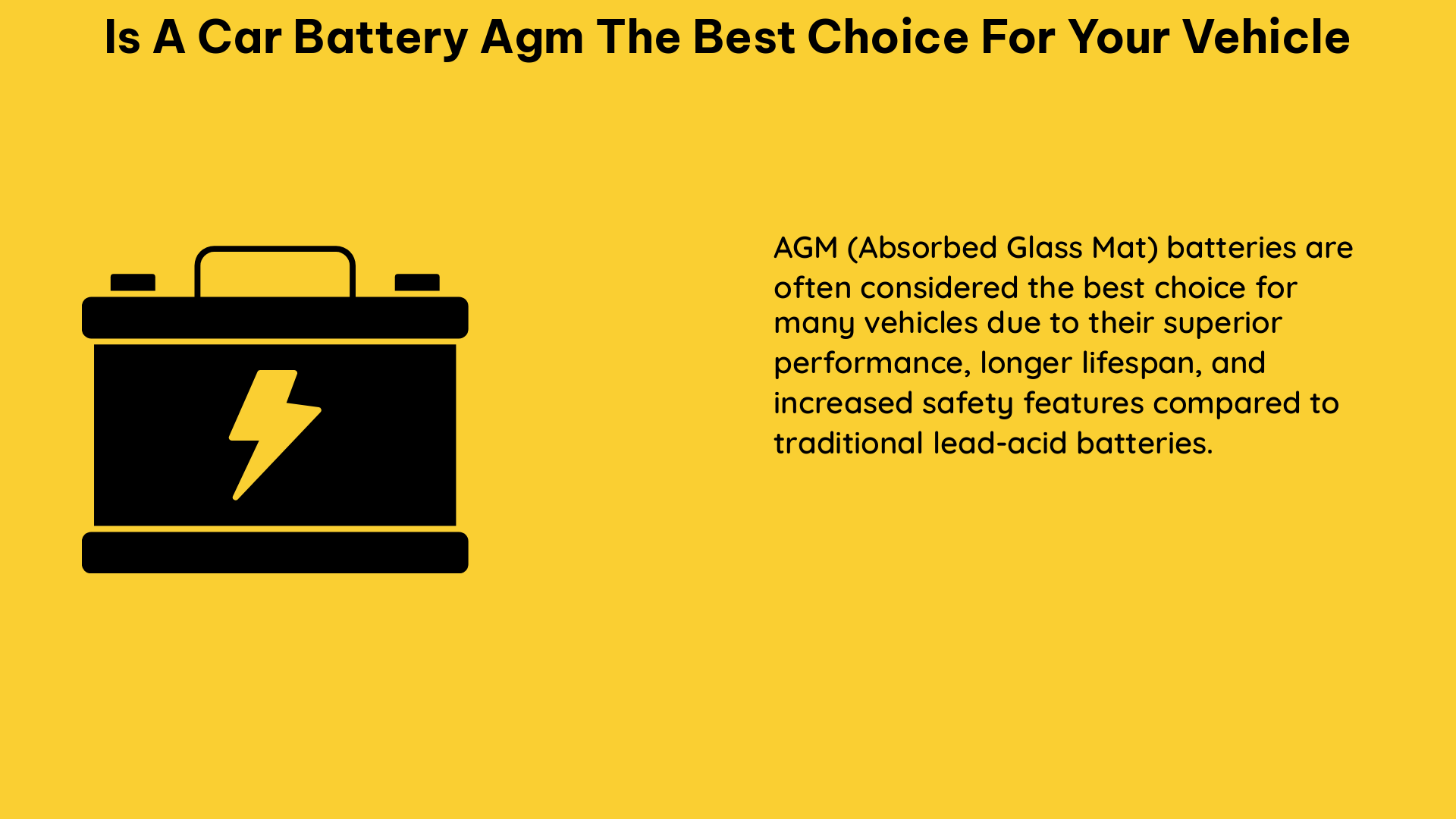An AGM (Absorbent Glass Mat) battery is a type of lead-acid battery that offers several advantages over a standard car battery, including lower maintenance requirements, increased toughness, and better resistance to corrosion and sulfation. However, the decision to choose an AGM battery over a traditional lead-acid battery depends on various factors, such as your vehicle’s usage, driving conditions, and your personal preferences.
Understanding AGM Batteries
AGM batteries are a type of sealed lead-acid (SLA) battery that use a fiberglass mat to hold the electrolyte in place, rather than the liquid electrolyte found in traditional lead-acid batteries. This design offers several benefits:
-
Maintenance-Free Operation: AGM batteries are sealed and do not require periodic water refilling, making them a low-maintenance option. The sealed design also allows them to be installed in any orientation, including upside-down or on their side, without the risk of leakage.
-
Improved Vibration Resistance: The fiberglass mat and sealed construction of AGM batteries make them more resistant to vibrations and shocks, making them a suitable choice for vehicles used in off-road or high-performance applications.
-
Enhanced Cycle Life: AGM batteries have a longer cycle life compared to traditional lead-acid batteries, meaning they can withstand more charge and discharge cycles before needing replacement.
-
Better Charge Acceptance: AGM batteries can accept a higher charging current, allowing them to be recharged more quickly than standard lead-acid batteries.
-
Improved Corrosion Resistance: The sealed design of AGM batteries reduces the risk of electrolyte leaks and subsequent corrosion of the battery terminals and surrounding components.
Comparing AGM and Standard Lead-Acid Batteries

When considering whether an AGM battery is the best choice for your vehicle, it’s important to understand the key differences between AGM and standard lead-acid batteries:
| Feature | AGM Battery | Standard Lead-Acid Battery |
|---|---|---|
| Maintenance | Virtually maintenance-free | Requires periodic water refilling |
| Vibration Resistance | Highly resistant to vibrations and shocks | More susceptible to vibration damage |
| Cycle Life | Longer cycle life (300-500 cycles) | Shorter cycle life (200-300 cycles) |
| Charge Acceptance | Accepts higher charging currents | Slower charging rates |
| Corrosion Resistance | Highly resistant to corrosion | More susceptible to terminal corrosion |
| Cost | Higher initial cost | Lower initial cost |
Factors to Consider When Choosing an AGM Battery
When deciding whether an AGM battery is the best choice for your vehicle, consider the following factors:
-
Vehicle Usage: If your vehicle is used for off-road activities, towing, or other high-stress applications, an AGM battery may be a better choice due to its improved vibration resistance and cycle life.
-
Driving Conditions: If your vehicle is regularly exposed to extreme temperatures, high humidity, or other harsh environmental conditions, an AGM battery’s resistance to corrosion and improved charge acceptance may be beneficial.
-
Maintenance Preferences: If you prefer a low-maintenance battery option, an AGM battery’s sealed design and lack of required water refilling may be appealing.
-
Cost Considerations: While AGM batteries typically have a higher initial cost, their increased durability and longer lifespan may make them a more cost-effective choice in the long run, especially for vehicles with high-intensity usage.
-
Battery Size and Fit: Ensure that the AGM battery you choose is the correct size and fit for your vehicle, as AGM batteries may be slightly smaller than standard lead-acid batteries, requiring the use of new battery hold-downs.
Potential Drawbacks of AGM Batteries
While AGM batteries offer several advantages, there are a few potential drawbacks to consider:
-
Higher Cost: AGM batteries generally have a higher upfront cost compared to standard lead-acid batteries, which may be a deterrent for some consumers.
-
Limited Availability: AGM batteries may not be as widely available as standard lead-acid batteries, especially in certain geographic regions or for older vehicle models.
-
Compatibility Concerns: Ensure that the AGM battery you choose is compatible with your vehicle’s electrical system and charging system, as some vehicles may require specific battery types or have limitations on the maximum charging current.
-
Disposal Considerations: Like standard lead-acid batteries, AGM batteries contain lead and sulfuric acid, which must be disposed of properly in accordance with local environmental regulations.
Conclusion
In summary, an AGM battery can be an excellent choice for your vehicle, particularly if you have a high-intensity usage profile, operate in harsh environments, or prefer a low-maintenance battery option. However, the decision to choose an AGM battery should be based on a careful evaluation of your specific vehicle’s needs, driving conditions, and personal preferences. By understanding the advantages and potential drawbacks of AGM batteries, you can make an informed decision that best suits your vehicle and driving requirements.
References:
– What is an AGM Battery and What’s the Big Deal?
– AGM vs Flooded Cell Battery
– How Can I Tell If This is a Standard Lead-Acid Battery?
– AGM Battery: What You Need to Know
– AGM vs. Standard Battery: Which is Better for Your Car?

The lambdageeks.com Core SME Team is a group of experienced subject matter experts from diverse scientific and technical fields including Physics, Chemistry, Technology,Electronics & Electrical Engineering, Automotive, Mechanical Engineering. Our team collaborates to create high-quality, well-researched articles on a wide range of science and technology topics for the lambdageeks.com website.
All Our Senior SME are having more than 7 Years of experience in the respective fields . They are either Working Industry Professionals or assocaited With different Universities. Refer Our Authors Page to get to know About our Core SMEs.